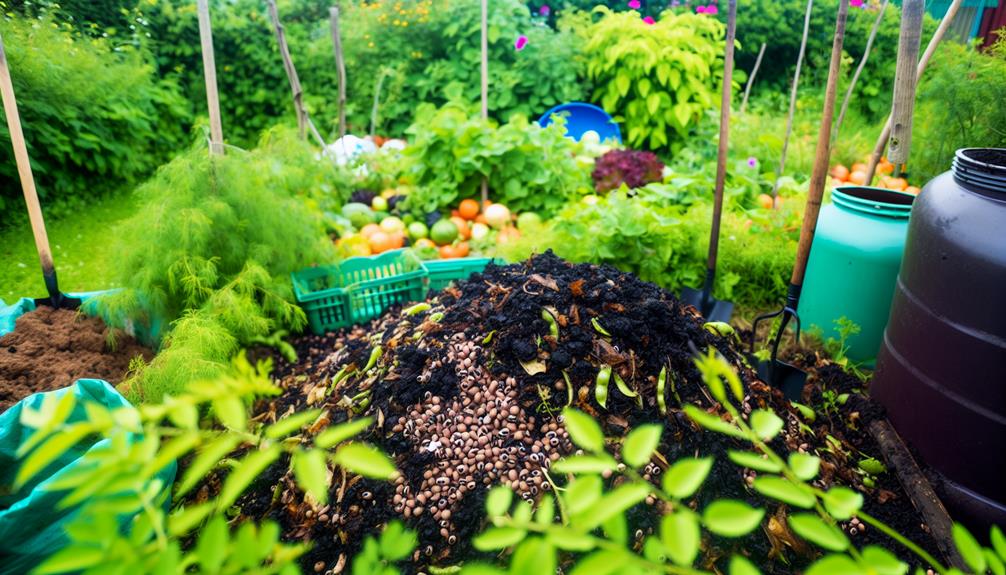

Yes, you can compost black-eyed peas, and it’s a great idea! These nutrient-packed legumes enrich your compost with valuable nitrogen, which is essential for healthy plant growth. Simply chop them into smaller pieces to speed up decomposition and mix them with other compost materials.
Make sure to balance your greens like peas with browns such as dried leaves to keep the compost process smooth. Turning your compost pile regularly will guarantee better aeration and faster breakdown. Plus, composting black-eyed peas not only reduces kitchen waste but also creates fantastic fertilizer for your garden. Interested in improving your composting skills?
Composting is a natural process that turns organic waste into valuable fertilizer for your garden. It’s an easy way to reduce waste and enrich your soil, creating a thriving environment for your plants.
To start, you’ll need a mix of green materials like fruit scraps and coffee grounds, and brown materials like dried leaves and cardboard. These materials break down with the help of microorganisms, moisture, and oxygen.
Turn your compost pile regularly to speed up the process and prevent odors. Remember, balance is key—too much green or brown can slow decomposition.
Black-eyed peas are more than just a staple in Southern cuisine; they’re packed with nutrients like protein, fiber, and essential vitamins. Thriving in warm climates, these legumes are relatively easy to grow, making them a favorite for home gardeners.
You’ll also find they come in various types, each offering unique flavors and textures that enhance countless dishes.
Packed with essential nutrients, black-eyed peas offer a robust profile of vitamins, minerals, and protein. They’re not just tasty; they’re nutritional powerhouses that can enhance your diet.
These legumes are rich in fiber, promoting digestive health, and they provide a significant amount of protein, making them great for vegetarians and vegans. Additionally, black-eyed peas are loaded with antioxidants, helping to protect your cells from damage.
Here’s a quick nutritional breakdown per 100 grams:
| Nutrient | Amount |
|---|---|
| Protein | 8 grams |
| Fiber | 6 grams |
| Iron | 2.5 mg |
| Magnesium | 60 mg |
| Vitamin A | 26 IU |
To enjoy the nutritional benefits of black-eyed peas, you’ll want to make sure they grow in the right conditions. These hearty legumes thrive in warm climates, so aim for temperatures between 70-85°F.
They need well-drained soil rich in organic matter, so consider adding compost to enrich the soil. Black-eyed peas prefer full sunlight, requiring at least six hours of direct sun daily.
Plant them in rows spaced about 2-3 feet apart to guarantee good air circulation and prevent disease. Water them consistently, but avoid waterlogging the soil.
They’re relatively drought-tolerant once established, making them perfect for community gardens or home plots. By giving them the proper care, you’ll create a flourishing and nourishing addition to your garden.
Among the many culinary uses for black-eyed peas, you’ll find they’re a versatile ingredient in a variety of dishes. You can add them to soups, salads, and stews, bringing a rich, earthy flavor that complements other ingredients beautifully.
They’re a staple in Southern cuisine, often featured in dishes like Hoppin’ John, a comforting mix of peas, rice, and sometimes bacon. You can also mash black-eyed peas into a dip or spread, perfect for a hearty snack. Their subtle taste pairs well with spices and herbs, allowing you to get creative in the kitchen.
Whether you’re cooking for a family gathering or a casual meal, incorporating black-eyed peas can make your dishes feel both traditional and innovative.
Also Read: Can You Compost Arugula?
When you compost black-eyed peas, you’re adding a valuable source of nitrogen to your compost pile, which is essential for plant growth. These peas also enhance soil structure, making it more fertile and easier for plants to access nutrients.
Black-eyed peas are rich in nitrogen, making them an excellent addition to your compost pile. When you add these legumes, you’re not just discarding waste; you’re contributing an essential nutrient that plants crave. Nitrogen is crucial for plant growth because it helps build proteins and other critical compounds.
By composting black-eyed peas, you guarantee your compost has the right balance of green materials, which accelerates decomposition and enriches the final product. This means your garden soil will be more fertile, leading to healthier, more vibrant plants.
Did you know that composting black-eyed peas can greatly enhance soil structure by contributing essential nutrients?
When you add black-eyed peas to your compost, they break down and release important nutrients like nitrogen, phosphorus, and potassium. These nutrients enrich the compost, which, when mixed with soil, improves its texture and fertility.
Better soil structure means your plants’ roots can access air and water more easily, leading to healthier growth.
You’ll notice that the soil becomes more crumbly and less compact, which helps prevent waterlogging and root rot. By incorporating composted black-eyed peas into your garden, you’re creating a more supportive environment for your plants to thrive.
It’s a simple, natural way to boost your garden’s health and productivity.
To facilitate the breakdown of black-eyed peas in your compost, make sure they’re cut into smaller pieces to accelerate decomposition. When you chop them up, you’re increasing their surface area, allowing microbes to work more efficiently.
Mixing the peas well with other compost materials guarantees they don’t clump together, promoting better aeration. Turn your compost pile regularly to keep it oxygenated, as this speeds up the breakdown process.
If you notice the compost becoming too dry, adding a bit of water helps maintain the necessary moisture levels. By following these steps, you secure that your black-eyed peas break down quickly, contributing rich nutrients to your compost and fostering a sense of community and shared purpose in sustainable living.
Also Read: Can You Compost Acorns?
Understanding the balance between green and brown materials is essential for creating effective compost. Green materials, like your black-eyed peas, add nitrogen, which fuels the microorganisms that break down compost. Think of green materials as the vital boost for your compost pile.

On the other hand, brown materials, such as leaves or straw, provide carbon, which is important for structure and aeration. You need both to create a thriving compost ecosystem. Aim for a ratio of about 2:1 browns to greens. This balance helps regulate moisture and prevents your pile from becoming too soggy or too dry.
It’s important to be aware of potential issues that can arise when composting black-eyed peas. These legumes can sometimes attract pests, lead to unpleasant odors, or introduce pathogens if not composted correctly. Ensuring the right balance of green and brown materials is essential to avoid these problems. Let’s break it down:
| Issue | Cause | Solution |
|---|---|---|
| Pests | Exposed food scraps | Bury under brown materials |
| Odors | Excess moisture or imbalance | Turn pile, add brown matter |
| Pathogens | Incomplete composting | Maintain proper temperature |
By following these tips, you can guarantee your composting process for black-eyed peas is smooth and effective. Composting is a community effort, and getting it right means benefiting everyone.

Follow these tips for a thriving compost pile that enriches your garden and supports your community!
Also Read: Can You Compost Ash From Wood?
Black-eyed peas offer several alternative uses that can enrich your garden and kitchen. You can use them as a nitrogen-fixing cover crop, which improves soil health by adding essential nutrients. This practice not only supports your plants but also fosters a sense of contributing to a sustainable environment.
In the kitchen, black-eyed peas are versatile, making delicious additions to soups, salads, and stews, connecting you to a rich culinary tradition. They’re also perfect for sprouting, providing fresh, homegrown greens year-round.
As you explore the world of composting black-eyed peas, you’ll find that their benefits extend far beyond the garden. These humble legumes can enrich your compost pile, offering nutrients that boost plant health and soil vitality. By composting black-eyed peas, you’re joining a community of eco-conscious individuals dedicated to sustainability.
Consider these key points:
Embrace the power of composting black-eyed peas, and you’ll contribute to a greener, more sustainable world.
